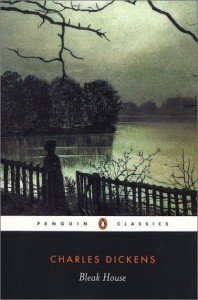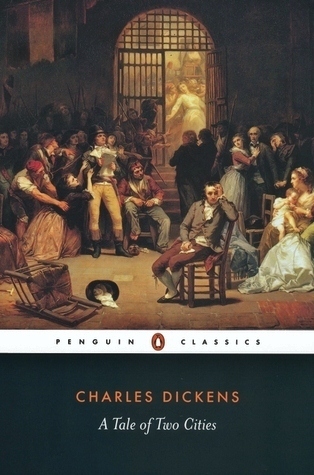
This was a marathon reading task, but I’m quite pleased that I finished it. I liked it. A lot. Unlike Little Dorrit, which I thought needed editing, I enjoyed all aspects of this novel.
Here is a synopsis from Wikipedia
Sir Leicester Dedlock and Honoria, Lady Dedlock (his junior by more than twenty years) live at his estate of Chesney Wold. Unbeknownst to Sir Leicester, Lady Dedlock had a lover, Captain Hawdon, before her marriage to Sir Leicester — and had a child by him, Esther Summerson. Lady Dedlock, believing her daughter to be dead, has chosen to live out her days ‘bored to death’ as a fashionable lady of the world.
Esther is raised by Miss Barbary, Lady Dedlock’s spartan sister, who instills a sense of worthlessness in her that Esther will battle throughout the novel. Esther does not realize that Miss Barbary is her aunt, thinking of her only as her godmother. When Miss Barbary dies, the Chancery lawyer “Conversation” Kenge takes charge of Esther’s future on the instruction of his client, John Jarndyce. Jarndyce becomes Esther’s guardian, and after attending school in Reading for six years, she goes to live with him at Bleak House, along with his wards, Richard Carstone and Ada Clare. Esther is to be Ada’s companion.
Esther soon befriends both Ada and Richard, who are cousins. They are named beneficiaries in one of the wills at issue in Jarndyce and Jarndyce; their guardian is a beneficiary under another will, and in some undefined way the two wills conflict. Richard and Ada soon fall in love, but though Mr. Jarndyce does not oppose the match, he does stipulate that Richard (who suffers from inconstancy of character) must first choose a profession. When Richard mentions the prospect of benefiting from the resolution of Jarndyce and Jarndyce, John Jarndyce beseeches him never to put faith in what he calls “the family curse”.
Meanwhile, Lady Dedlock is also a beneficiary under one of the wills in Jarndyce and Jarndyce. Early in the book, while listening to her solicitor, the close-mouthed but shrewd Mr. Tulkinghorn, read an affidavit aloud, she recognizes the handwriting on the copy. The sight affects her so much that she almost faints, which Tulkinghorn notes and thinks important enough to investigate. He recognizes that Lady Dedlock has focused on the affidavit’s handwriting, and seeks to trace the copyist. He discovers that the copyist was a pauper known only as “Nemo” and that he has recently died. The only person to identify him is a street-sweeper, a poor homeless boy named Jo.
Lady Dedlock also investigates the matter, disguising herself as her French maid, Mademoiselle Hortense. In disguise, she pays Jo to take her to Nemo’s grave. Meanwhile, convinced that Lady Dedlock’s secret might be a threat to the interests of his client, Sir Leicester Dedlock, Tulkinghorn begins to watch her every move, even enlisting the aid of the maid, who detests her.
Esther happens to meet her mother unwittingly at a church service and has a conversation with her afterwards at Chesney Wold – though, at first, neither woman recognizes the tie that binds them. Later, Lady Dedlock realises that her abandoned child is not dead, but is, in fact, Esther. She waits to confront Esther with this knowledge until Esther has survived a bout with an unidentified disease (possibly smallpox, as it permanently disfigures her), which she contracted from her maid Charley (whom she devotedly nursed back to health). Though they are happy at being reunited, Lady Dedlock tells Esther that they must never recognize their connection again.
Meanwhile, Esther has recovered her health, but her beauty is supposedly ruined. She finds that Richard, having tried and failed at several professions, has ignored his guardian’s advice and is wasting all his resources in trying to push Jarndyce and Jarndyce to a conclusion (in his and Ada’s favour). Further, he has broken with his guardian, under the influence of his lawyer, the odious and crafty Mr. Vholes. In the process of becoming an active litigant, Richard has lost all his money and is breaking his health. In further defiance of John Jarndyce, he and Ada have secretly married, and Ada is carrying Richard’s child. Esther experiences her own romance when Dr. Woodcourt, who knew her before her illness, returns from his mission and continues to seek her company despite her disfigurement. Unfortunately, Esther has already agreed to marry her guardian, John Jarndyce.
Hortense and Tulkinghorn discover the truth about Lady Dedlock’s past. After a quiet but desperate confrontation with the lawyer, Lady Dedlock flees her home, leaving a note apologizing for her conduct. Tulkinghorn dismisses Hortense, no longer any use to him. Feeling abandoned and betrayed by Lady Dedlock and Tulkinghorn, Hortense kills Tulkinghorn and seeks to frame Lady Dedlock for his murder. On discovering his lawyer’s death and his wife’s flight, Sir Leicester suffers a catastrophic stroke but manages to communicate that he forgives his wife and wants her to return to him.
Inspector Bucket, who up to now has investigated several matters on the periphery of Jarndyce and Jarndyce, accepts the commission of the stricken Sir Leicester to find Lady Dedlock. He suspects Lady Dedlock, even after he arrests George Rouncewell (the only other person known to be with Tulkinghorn on the night of the murder, and known to have quarrelled with the lawyer repeatedly). Nonetheless, Bucket pursues the charge given to him by Sir Leicester and ultimately calls on Esther to assist in the search for Lady Dedlock. By this point, Bucket has cleared Lady Dedlock’s name by discovering Hortense’s guilt, but she has no way to know this, and, wandering London in cold and bitter weather, she ultimately dies at the cemetery where her former lover Captain Hawdon (Nemo) is buried. Esther and Bucket find her there.
Developments in Jarndyce and Jarndyce seem to take a turn for the better when a later will is discovered which revokes all previous wills and leaves the bulk of the estate to Richard and Ada. At the same time, John Jarndyce releases Esther from their engagement and she and Dr. Woodcourt become engaged. They go to Chancery to find Richard and to discover what news there might be of the lawsuit’s resolution. To their horror, they discover that the new will is given no chance to resolve Jarndyce and Jarndyce, for the costs of litigation have consumed the estate, and as there is nothing left to litigate, the case melts away. After hearing this, Richard collapses, and Dr Woodcourt determines that he is in the last stages of consumption. Richard apologizes to John Jarndyce and succumbs, leaving Ada alone with their child, a boy whom she names Richard. Jarndyce takes in Ada and the child. Esther and Woodcourt marry and live in Yorkshire, in a house which Jarndyce gives to them. In time, they have two daughters.
Many of this intricate novel’s subplots deal with the minor characters and their diverse ties to the main plot. One of these subplots is the hard life and happy though difficult marriage of Caddy Jellyby and Prince Turveydrop. Another focuses on George Rouncewell’s rediscovery of his family at Chesney Wold and his reunion with his mother and brother.
There is so much going on in this novel – mystery, romance, court drama. Esther Summerson is another unbelievably good heroine ( a bit like Amy Dorrit). The characters are brilliant – Mr Bucket, Mrs Jellyby and her African causes, the child-like Mr Skimpole, the lovely Allan Woodcourt and the lost Richard Carstone.
This is my favourite Dickens so far…
Here are some other reviews …
http://www.smittenbybritain.com/2010/08/great-british-literature-bleak-house.html
http://www.chrisbookarama.com/2008/01/bleak-house-review.html




